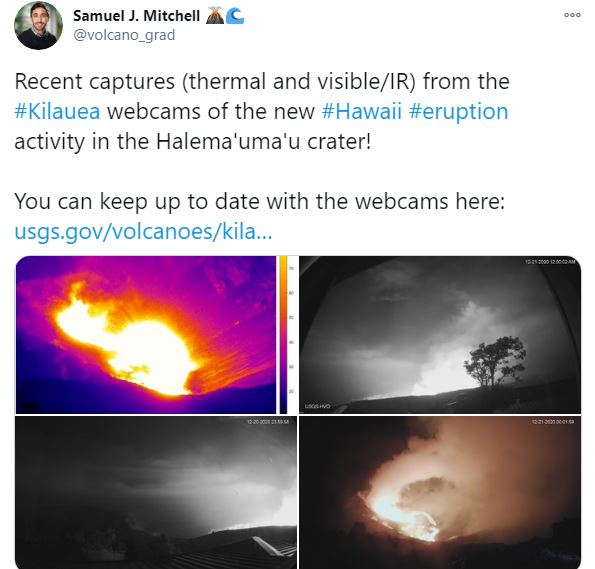Kīlauea, an active shield volcano on Hawaii's Big Island, has begun erupting on Sunday night (December 20) following a series of earthquakes. The Hawaii city Civil Defence Agency (COH) has asked residents to stay indoors as the volcano continues to erupt.
The Hawaii Volcanoes National Park confirmed the news on Twitter. In a statement, USGS Hawaiian Volcano Observatory (HVO) said that shortly after 9:30 pm (local time), the environmental agency detected "glow within Halemaʻumaʻu crater at the summit of Kīlauea Volcano. An eruption has commenced within Kīlauea's summit caldera."
According to the statement, the situation is "rapidly evolving", and the authority will provide another statement when more information is available. "HVO has elevated Kīlauea's volcano alert level to WARNING and its aviation color code to RED," added in the statement.
Video from W rim of the caldera just before midnight. As of December 21 at 1:30 a.m. HST, the growing lava lake has almost reached the level of the lowest down-dropped block that formed during the 2018 collapse events. Over the past 2 hours, the lake has risen by ~10 m (32 ft). pic.twitter.com/Qbx1d6hbq4
— USGS Volcanoes🌋 (@USGSVolcanoes) December 21, 2020
Warning
The NOAA's National Weather Service said that the ash caused by volcanic eruption will likely fall in communities of Pahala, Wood Valley, Ocean View, and Naalehu. The agency also cautioned local residents to avoid excessive exposure to ash, which could cause eye and respiratory irritation. "Those with respiratory sensitivities should take extra precaution to minimize exposure," it said.
COH also asked people to stay indoors and said in a Tweet that "trade winds will push any embedded ash toward the Southwest." The advisory comes after a 4.4 magnitude earthquake hit near Hilo on Sunday, according to the USGS's earthquake monitoring website. It also revealed that at least seven other earthquakes ranging between 2.5 and 2.7-magnitude have hit the region over the previous few hours.

Live panorama of Halemaʻumaʻu, water lake, and down-dropped block from the west rim of the new summit collapse features. USGS Hawaiian Volcano Observatory webcam: https://t.co/UiRpFevCTs #kilauea #volcano #hawaii pic.twitter.com/9LWxlWyYAQ
— Ryan Kawailani Ozawa (@hawaii) December 21, 2020
RT Volcanoes_NPS "RT @USGSVolcanoes: Red spots are the approximate locations of vents feeding lava flowing into the bottom of Halema‘uma‘u crater. The water lake has been replaced with a growing lava lake. The easternmost vent is currently exhibiting… pic.twitter.com/gzfdZdfl64"
— rsghawaii (@RSG_Hawaii) December 21, 2020
Kīlauea Volcano
It is Hawaii's most active volcano that last erupted in 2018. HVO, which has been monitoring the activity of the volcano, said that for the past few weeks, it recorded "ground deformation and earthquake rates" at the Kīlauea Volcano's summit and upper East Rift Zone.
In a statement, USGS/HVO added that "while uplift related to post-collapse inflation of the summit reservoir has been occurring since March of 2019, rates have been steadily increasing in recent months and are currently higher than they have been since the end of the 2018 eruption."
On December 17, according to HVO, the seismometers detected an increase in "occurrence and duration of long-period seismic signals beneath Kīlauea's summit, which are attributed to magmatic activity."









